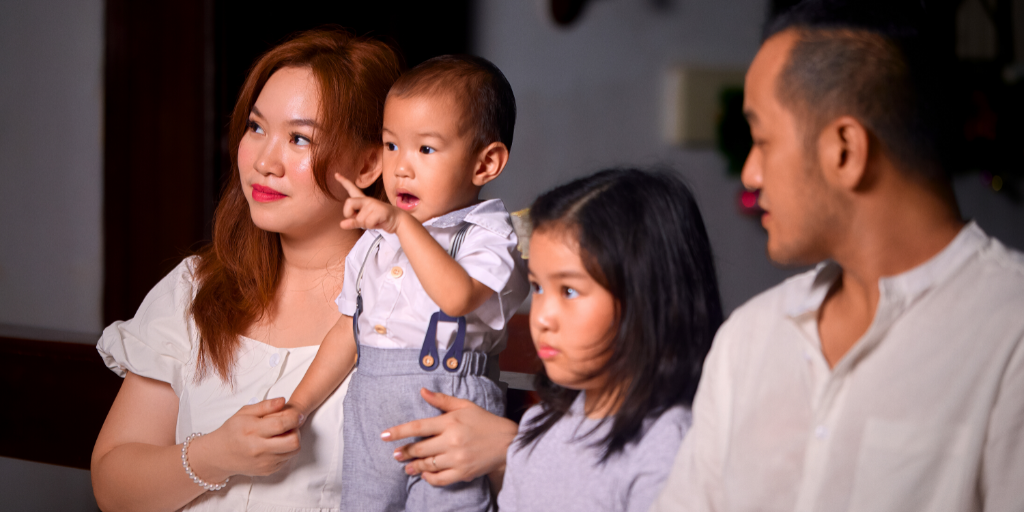
Betsy Kerekes emphasizes four ways to plan ahead when gearing up to take your kids to Mass.
Parents of young children employ various techniques for making it through Mass in relative peace for themselves and those around them. Below are several options.
First are parents who take turns going to Mass so as to leave the small ones at home. The obvious perk is having a much more relaxing Mass experience, especially when you want to be able to pay close attention to the priest for a change. The potential problem is, when the children are deemed old enough to attend Mass, they might rebel against suddenly having to dress nicely and sit quietly for an hour, as opposed to running free at home in their pajamas.
Practice makes perfect
Some parents ascribe to the practice-makes-perfect mindset, where the more you go, the better the kids will behave, hence daily Mass. Or, at least, the law of averages states that the chances of the kids being bad with the largest audience, a.k.a. Sunday Mass, decrease the more often they go.
Other parents sit in the front row where, instead of looking at the backs of peoples’ heads, their children can better pay attention to what’s happening on the altar. It may help, too, if Mom or Dad whisper explanations of each part of the Mass throughout.
There’s also the cry room. Here you don’t have to concentrate quite as much on keeping your children quiet, though not all cry rooms are created equal. Some are tolerable, but in others, it doesn’t feel like you’re in Mass at all, especially when children and parents speak at full volume.
Toys or no toys?
Some parents bring "busy bags" that contain lacing cards, coloring pages, and other activities. Stickers and paper have been known to work well, even if parents’ arms, legs, and clothes are used more often than the paper. Finger puppets also seem to be popular, especially when they’re fabric so if they fall off your hand, it's a silent fall.
You can’t go wrong with books, especially if they’re about saints, the Mass, or an age-appropriate Baltimore Catechism. If the book provides pictures and explanations of the different parts of the Mass, you can help your child follow along.
When my kids were younger, I would hand them a missalette and ask them to find page 216, or count how many pictures are on the pages, or find a word that starts with A, etc. These had the double benefit of keeping them quiet and occupied while practicing number and letter skills.

Set clear expectations
Some parents are adamant about no toys in church. Instead, they set clear behavioral expectations, even making a poster labeled “Mass Rules!” (Double meaning there.) Parents might quiz their children or offer a treat for someone who tells something they learned at Mass in order to motivate them to pay attention.
Another option is setting goals and charting progress, with rewards for individual successes (who doesn’t love lighting a votive candle?) and bigger rewards for a track record of success, like good behavior for a month. So your children will want to work as a team, you could also offer group rewards, such as eating out after Mass, staying up later, or a special dessert or movie.
There could also be consequences for bad behavior, like going to bed early. Just don’t make prayers or reading the Bible a punishment. You don’t want your children to have a negative association with holy things.
Consider the Mass and parish
Are you going at the right time? Perhaps your children are more sedate at 9 am than they are at 11:30. Maybe you want a Mass with a children’s liturgy to give yourselves a breather.
If you want your children to respect the Mass, find a parish with the most hard-core priest and parishioners. Note how people are dressed. Are 80% of them wearing Sunday best, or shorts and flip flops? Which manner of dress is more likely to put the wearer in the proper frame of mind for receiving Jesus?
This may mean switching parishes, but it will be worth it, especially if the new church serves donuts afterward. I kid; however, those dough balls of deliciousness are great motivators for children to behave. One mom told me her child nudged a sibling, indicated his properly folded hands, and whispered, “Donut hands.”

Whatever works for you, find your niche so together, you, your spouse, and your children will have a more peaceful and meaningful Mass experience.
Share your thoughts with the Catholic Mom community! You'll find the comment box below the author's bio and list of recommended articles.
Copyright 2024 Betsy Kerekes
Images: Canva
This article is an excerpt from the “Children at Church” chapter of Betsy's book, Be a Happier Parent or Laugh Trying, available from OSVCatholicBookstore.com.
About the Author

Betsy Kerekes
Betsy Kerekes is the author of Be a Happier Parent or Laugh Trying (Our Sunday Visitor 2019) and coauthor with Dr. Jennifer Roback Morse of 101 Tips for Marrying the Right Person (Ave Maria Press 2016) and 101 Tips for a Happier Marriage (Ave Maria Press 2013). She is Senior Editor for The Ruth Institute.


.png?width=1806&height=731&name=CatholicMom_hcfm_logo1_pos_871c_2728c%20(002).png)
Comments